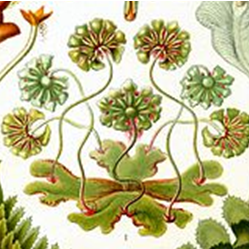
Bryophyte papers
@bry_papers
Followers
1K
Following
12
Media
0
Statuses
2K
Scraping Google Scholar, PubMed, 'Lindbergia', 'The Bryologist', 'Cryptogamie, Bryologie', then my dlvr.it account maxed out : (
Global
Joined September 2014
A hidden herbivory effect on Sphagnum reproduction
pubmed.ncbi.nlm.nih.gov
Defence theories provide predictions about trade-offs in the allocation of resources to defence and growth. However, very little is known about how pressure from herbivores influences the allocation...
0
0
3
The remediation of marine sediments containing polycyclic aromatic hydrocarbons by peroxymonosulfate activated with Sphagnum moss-derived biochar and its benthic microbial ecology
pubmed.ncbi.nlm.nih.gov
This research was to study the efficiency of Sphagnum moss-derived biochar (SMBC) in removing polycyclic aromatic hydrocarbons (PAHs) from marine sediment using a peroxymonosulfate (PMS)-based...
0
0
0
Thermospermine is an evolutionarily ancestral phytohormone required for organ development and stress responses in Marchantia polymorpha
pubmed.ncbi.nlm.nih.gov
Thermospermine suppresses auxin-inducible xylem differentiation, whereas its structural isomer, spermine, is involved in stress responses in angiosperms. The thermospermine synthase, ACAULIS5 (ACL5),...
0
0
2
The complete chloroplast genome of Porella gracillima Mitt. (Porellaceae) and phylogenetic relationships to other bryophytes
pubmed.ncbi.nlm.nih.gov
Porella gracillima Mitt. (Jungermanniidae, Porellaceae), a bryophyte is widespread in temperate Asia and North America. In Korea, P. gracillima is mainly observed in shaded and dried rocks or tree...
0
0
1
Vascular plants and mosses as bioindicators of variability of the coastal pine forest (Empetro nigri-Pinetum)
pubmed.ncbi.nlm.nih.gov
Empetro nigri-Pinetum is a unique sea coast plant community developing along the Baltic Sea from Germany to Lithuania. Our detailed field research of bryophytes and vascular plants has highlighted...
0
0
2
Life under the snow: A year-round transcriptome analysis of Antarctic mosses in natural habitats provides insight into the molecular adaptation of plants under extreme environment
pubmed.ncbi.nlm.nih.gov
Mosses are vital components of ecosystems, exhibiting remarkable adaptability across diverse habitats from deserts to polar ice caps. Sanionia uncinata (Hedw.) Loeske, a dominant Antarctic moss...
0
4
8
ROS scavenging enzyme-encoding genes play important roles in the desert moss Syntrichia caninervis response to extreme cold and desiccation stresses
pubmed.ncbi.nlm.nih.gov
Abiotic stress is one of the major environmental constraints limiting plant growth. Syntrichia caninervis is one of the unique plant models that can cope with harsh environments. Reactive oxygen...
0
0
0
Active moss biomonitoring of airborne potentially toxic elements in recreational areas of Moscow
pubmed.ncbi.nlm.nih.gov
Active biomonitoring using the moss bag technique was applied to examine the atmospheric deposition of potentially toxic and other elements in recreational areas of Moscow. Moss bags with Sphagnum...
0
0
0
Glutamate dehydrogenase in "Liverworld"-A study in selected species to explore a key enzyme of plant primary metabolism in Marchantiophyta
pubmed.ncbi.nlm.nih.gov
In plants, glutamate dehydrogenase (GDH) is an ubiquitous enzyme that catalyzes the reversible amination of 2-oxoglutarate in glutamate. It contributes to both the amino acid homeostasis and the...
0
1
1
Relationships among sporophytic and gametophytic traits of 27 subtropical montane moss species
pubmed.ncbi.nlm.nih.gov
Our study highlights that the central strand in the seta may have an important functional role and affect the allometry of moss sporophytes. The coordinated variations in sporophyte morphological and...
0
0
4
Differential expansion and retention patterns of LRR-RLK genes across plant evolution
pubmed.ncbi.nlm.nih.gov
To maximize overall fitness, plants must accurately respond to a host of growth, developmental, and environmental signals throughout their life. Many of these internal and external signals are...
0
0
1
Mercury accumulation efficiency of different biomonitors in indoor environments: the case study of the Central Italian Herbarium (Florence, Italy)
pubmed.ncbi.nlm.nih.gov
Biomonitoring studies are often employed to track airborne pollutants both in outdoor and indoor environments. In this study, the mercury (Hg) sorption by three biomonitors, i.e., Pinus nigra bark,...
0
0
0
Molecular and phylogenetic evidence of parallel expansion of anion channels in plants
pubmed.ncbi.nlm.nih.gov
Aluminum-activated malate transporters (ALMTs) and slow anion channels (SLACs) are important in various physiological processes in plants, including stomatal regulation, nutrient uptake, and in...
0
0
1
Recent Advances in the Phytochemistry of Bryophytes: Distribution, Structures and Biological Activity of Bibenzyl and Bisbibenzyl Compounds
pubmed.ncbi.nlm.nih.gov
Research on bryophyte phytochemistry has revealed the presence of different phytochemicals like fatty acids, terpenoids, small phenolic molecules, etc. Small phenolic molecules, i.e., bibenzyls (of...
0
0
3
The use of sentinel-2 imagery to generate vegetations maps for the Northern Antarctic peninsula and offshore islands
pubmed.ncbi.nlm.nih.gov
We used Sentinel-2 imagery time series to generate a vegetation map for the Northern part of the Antarctica Peninsula and offshore islands, including the South Shetlands. The vegetation cover was...
0
0
1
An ABCB transporter regulates anisotropic cell expansion via cuticle deposition in the moss Physcomitrium patens
pubmed.ncbi.nlm.nih.gov
Anisotropic cell expansion is crucial for the morphogenesis of land plants, as cell migration is restricted by the rigid cell wall. The anisotropy of cell expansion is regulated by mechanisms acting...
0
0
1
Drying without Dying: a genome database for desiccation-tolerant plants and evolution of desiccation tolerance
pubmed.ncbi.nlm.nih.gov
Desiccation is typically fatal, but a small number of land plants have evolved vegetative desiccation tolerance (VDT), allowing them to dry without dying through a process called anhydrobiosis....
0
0
2
Potential implications of shortened rotation length for forest birds, bryophytes, lichens and vascular plants: An example from southern Swedish production forests
pubmed.ncbi.nlm.nih.gov
The rotation lengths of intensively managed production forests may be altered to achieve a variety of goals, with correspondingly implications for biodiversity. Here we consider the potential...
0
0
1
Is a Combination of Metals More Toxic to Mosses Than a Single Metal?
pubmed.ncbi.nlm.nih.gov
Increasing pollution in the environment calls for the precise determination of metal toxicity in plants as they are at the base of the food chain. Mosses are often employed as biomonitors and provide...
0
0
1
Plastome diversity and evolution in mosses: Insights from structural characterization, comparative genomics, and phylogenetic analysis
pubmed.ncbi.nlm.nih.gov
Mosses play a significant role in ecology, evolution, and the economy. They belong to the nonvascular plant kingdom and are considered the closest living relatives of the first terrestrial plants....
0
0
1


